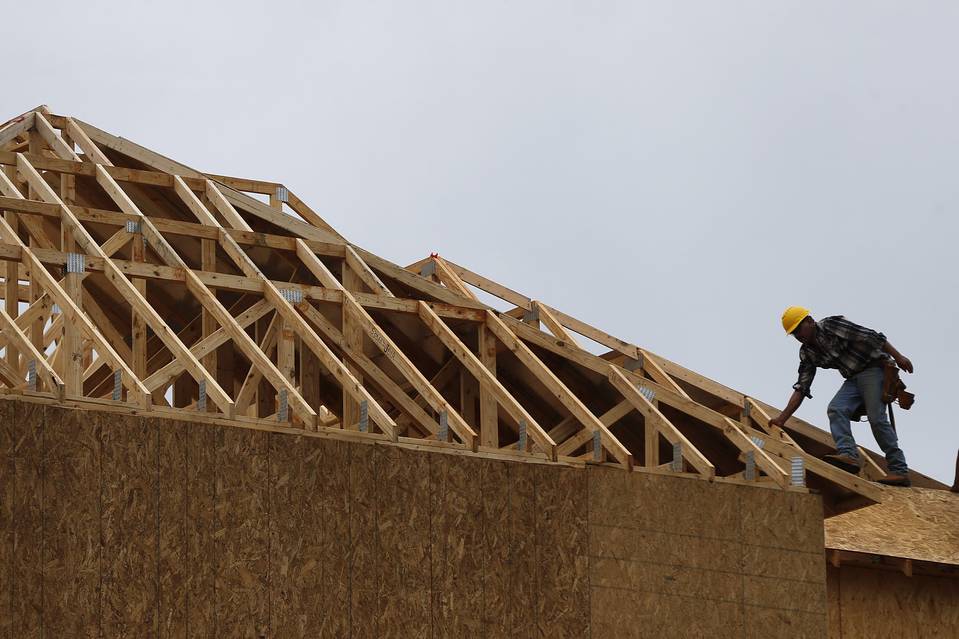Buying new construction seems simple, right? Just select the floor plan you would like, choose the perfect lot, and watch it go up. No sellers to deal with, no unexpected repairs that come up during inspection, no drawn-out negotiations. Right? See why here
The reasons you Have to have a Buyer’s Agent When buying New Construction
Builders forecast massive development in building
Construction of single-family homes is expected to gradually rise this year, as a growing economy, solid employment gains and rising household formation buoys builders forecasts. See details here
 Builders forecast massive development in building
Builders forecast massive development in building
Which happens to be Cheaper: To purchase or Build New?
Obviously, there exists quite a bit of variations in sorting out those costs. Plus, the price you pay upfront is only part of the equation when deciding to buy an existing home or build a new one. Find out here
 Which happens to be Cheaper: To purchase or Build New?
Which happens to be Cheaper: To purchase or Build New?
Builders Go back to Once-Abandoned Ventures
The supply of buildable lots is shrinking. Which has prompted home builders to return to the abandoned lots left behind during the housing crisis in efforts to revive dwindling inventories of homes for-sale, The Wall Street Journal reports. See the details here
 Builders Go back to Once-Abandoned Ventures
Builders Go back to Once-Abandoned Ventures
Tired of White? 2017’s Color of the Year Go to a Dark Place
Within the world of home decor, the color white (or possibly is it non-color?) has reigned supreme for quite a while. However the everything-white fad is apparently fading. Want proof? Paint companies Sherwin-Williams and Benjamin Moore have both recently announced their 2017 Color of the Year, and they’ve taken a decidedly darker turn. See 2017 Color of the Year
 Tired of White? 2017’s Color of the Year Go to a Dark Place
Tired of White? 2017’s Color of the Year Go to a Dark Place
A 5-Point Action Plan for Your New Place
A 5-Point Action Plan for Your New Place

After waiting weeks for the keys to your new home, you probably want to treat yourself to something nice.
Here are some quick home improvements you'll likely be happy with:
1. Practical problems first.
Prioritize easy repairs and upgrades that affect your day-to-day living, such as leaky faucets, dirty or worn fixtures, poor paint choices, holes that need patching or flooring that needs updating.
2. Head-to-toe detail.
Detailing isn't just for your vehicle. Your new home deserves deep cleaning, too. Take advantage of it being completely empty, and hire someone to clean every inch.
3. Consider the view.
The right window treatments improve a home’s ambiance, comfort and privacy. They can even save you money in the long run. Drapes, curtains, blinds and shutters block unwanted light, let in the right amount of sunshine and keep your home warm or cool when drawn or shut.
4. Bright ideas.
Proper lighting also affects your comfort. After you arrange furniture, pay close attention for a few weeks and note which areas are too dark and which get too much light. From there, you can decide whether new overhead lightning, lamps or bulbs will do the trick.
5. The right appliances.
Major appliances – refrigerators, dishwashers, washing machines, dryers and stoves – impact your daily life, your home's appearance and your utility bills. Purchasing the right appliances now can set you up for savings and efficiency for years to come.
Just starting the home buying process? Contact Nick & Cindy Davis who will help you find the right place.
A 5-Point Action Plan for Your New Place, getting settled, Action Plan, moving into new place
Books About Moving to Read to Your Kids
Books About Moving to Read to Your Kids
Moving to a new home, a new neighborhood and a new school can be tough for kids. Luckily, a variety of children’s books are out there to help parents explain things, add some fun and hopefully alleviate fears.
Here are a few classics – and you can post your favorite children's book titles about moving in the comments section below:
1. “Alexander, Who's Not (Do You Hear Me? I Mean It!) Going to Move” by Judith Viorst
Atheneum Books for Young Readers, 1995
Poor Alexander. First, the kid had a Terrible, Horrible, No Good, Very Bad Day. Now, his family is moving! Just like your kids, Alexander has to say goodbye to some special places and people, but with the help of his parents he learns to make the most of the situation.
2. “The Berenstain Bears’ Moving Day” by Stan and Jan Berenstain
Random House Books for Young Readers, 1981
Little Brother Bear’s pretty worried about moving, and more than a little scared. Kids can relate to his apprehension, and hopefully his positive change of view as moving day gets closer.
3. “A House for Hermit Crab” by Eric Carle
Aladdin Paperbacks, 1987
A little hermit crab has outgrown his shell and needs to find a bigger one – and new friends to help decorate it. This book will reassure kids that it will be easy to make new friends in their new town.
4. “Tigger’s Moving Day” by Kathleen W. Zoehfeld
Disney, 1999
Tigger needs a place with more bouncing room! His friends aren’t as close to his new house, but they still come and visit. A story to help kids understand they’ll still be able to hold on to old connections.
5. “Goodbye House” by Frank Asch
Moonbear Books, 1989
This book is a terrific way to talk about moving with preschoolers. After the moving van is packed, a little bear returns to say farewell to his old house, saying goodbye to everything, except, of course, the memories.
Other favorites include: “Big Dan’s Moving Van,” by Leslie McGuire, “Neville,” by Norton Juster, “The Moving House” by Mark Siegel, “I’m Not Moving, Mama” by Nancy White Carlstrom, and “The Leaving Morning,” by Angela Johnston.
Looking to a move to a neighborhood that’s great for kids (and parents)? Nick & Cindy Davis have a team ready to assist you with. Meet the Team
4 Resources for First-Time Homebuyers
4 Resources for First-Time Homebuyers

Surveys show that first-time buyers aren’t aware of how much they need to save for a down payment. Many people believe that buying a home requires they put down at least 20 percent of the purchase price, but down payments aren’t as big of an obstacle as people think. For example, a loan through the Federal Housing Administration could require a down payment as low as 3.5 percent; Fannie Mae and Freddie Mac have similarly low requirements.
If you qualify for a loan with a low down payment but still have trouble coming up with the cash, here are a few of the many programs out there that can help. Do some research to find out what’s available in your area.
-
Help getting down
The federal Department of Housing and Urban Development (HUD) gives community development block grants to states and local governments across the country to help revitalize certain areas. HUD’s HOME Investment Partnerships Program(HOME) is one such program. States often have their own programs for down payment assistance, too. -
Opening up options for closing
The Federal National Mortgage Association, a.k.a. Fannie Mae, designed the HomePath Ready Buyer program to attract new homebuyers to the market. Through the program, qualifying first-time homebuyers can get assistance of up to 3 percent of closing costs after they pass an online homeownership course. -
Making ownership less taxing
Some state governments provide first-time buyers with a tax credit to boost homeownership. -
Helping heroes
The U.S. Department of Veterans Affairs (VA) Home Loan Guaranty Servicehelps veterans or surviving spouses obtain better terms for their mortgage by guaranteeing a portion of the loan. Some VA mortgages require no down payment.
Check the National Council of State Housing Agencies for more opportunities available in your state.
A buyer’s agent will be able to help you find the programs that operate in your area and are appropriate to your financial situation. Nick & Cindy Davis are here to assist you with your home purchase.
7 Ways to Meet Your New Neighbors
7 Ways to Meet Your New Neighbors
Now that you’ve settled into your new home, it’s time to the meet the neighbors. Here are a few tips to break the ice. Go ahead, don’t be shy!
1. Throw an informal happy hour
After all that unpacking (or staring exhaustedly at those boxes that need to be unpacked) hosting a party may be the last thing you want to do. But a casual gathering involves little effort. A couple bottles of wine, a few snacks and you’re set to meet new friends. Plus this is the one time you can get away with a disorganized house and still have people over — take advantage.
2. Get some fresh air
Hang out in your front yard or on your porch. Neighbors are much more likely to stop by to say hello if they see you sitting outside with a cup of coffee than if you’re inside and they have to knock on your door.
3. Go exploring
Jog through your new neighborhood instead of hitting the gym. Neighbors will at least wave, if not stop you for a quick chat.
4. Puppy pride
Walking your dog, or playing with him or her in your yard or local dog park, is an excellent way to meet people, especially other dog lovers.
5. Cruise garage sales
You might not want to actually buy anything since you just gave away a lot of accumulated junk before your move, but perusing garage sales is a great way to meet your neighbors. Check out the local paper or Craigslist to find out where to go.
6. Hang out with your kids
Volunteering at school or chatting with other parents at the playground can result in new friends for you and your kids.
7. Dust off those oven mitts
Bringing homemade cookies to the neighbors makes a great first impression. If you haven’t unpacked your kitchen, bakery or store-bought goodies will also be appreciated. Don’t forget to stop by with dog treats to make new canine friends as well!
7 Ways to Reduce Stress When Buying or Selling a Home
7 Ways to Reduce Stress When Buying or Selling a Home
Research has shown that buying or selling a home can be one of life’s most stressful events — right up there with filing for bankruptcy or getting a divorce. Preparation is the key to reducing anxiety. Here are a few tips:
1. Choose your agent carefully
An experienced pro will be prepared for every twist in the road, minimizing stress for you.
2. Home buyers: List before looking
Create and prioritize a list of “wants” and “needs” of home features before you begin touring properties. Waiting to think about what you’re truly looking for in a home until the showing will put you on the spot, creating anxiety.
3. Home buyers: Get mortgage preapproval
Having your finances ready eliminates white-knuckled waiting periods, or unpleasant surprises from lenders after you’ve found your dream home.
4. Don’t take things personally
It’s not you, it’s them. Or the market. Or the lender. Try not to take it personally if buyers value your home for less than what you’re asking, or if a seller rejects what you believe is a perfectly reasonable offer.
5. Keep things in perspective
Consider the worst-case scenario. Will you have to forage for food? Will you need to sell a kidney? Probably not. Other buyers will eventually materialize. Or you’ll find another home you love just as much as the one that got away.
6. Focus on something else
Give yourself a break and indulge in an activity that requires the undivided attention of your body and mind. Yoga lessons, anyone?
7. Find a four-legged friend
Petting and playing with animals is clinically proven to lower your blood pressure. And they won’t interrupt if you need to vent.
Talking things through with Nick & Cindy Davis is another way to de-stress. You can contact us here: www.TampaHomesSold.com







